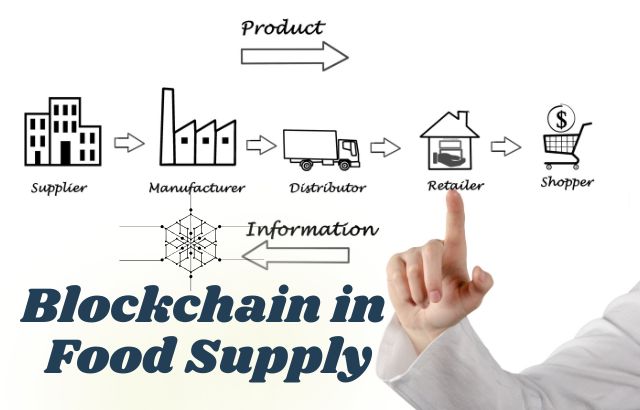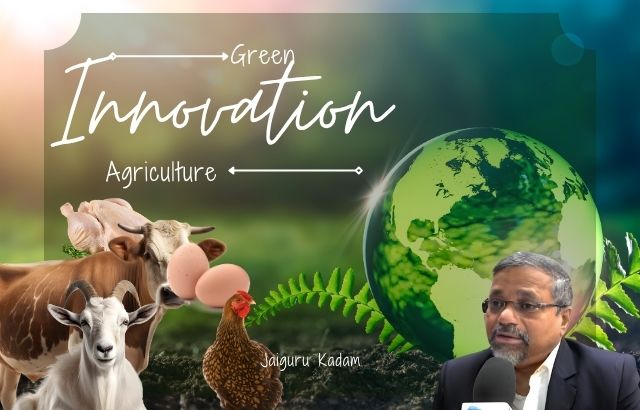Blockchain in Food Supply- In recent years, blockchain technology has emerged as a transformative force across various industries, and agriculture is no exception. By offering transparency, traceability, and efficiency, blockchain is revolutionizing food supply chains. This blog will explore how blockchain is being implemented in agriculture, backed by real-world examples, calculations from Green Innovator, and answers to frequently asked questions.
Blockchain in Food Supply – The Basics of Blockchain in Agriculture

At its core, blockchain is a decentralized digital ledger that records transactions across multiple computers. This ensures that records cannot be altered retroactively, fostering trust among all parties involved. In the context of agriculture, blockchain can track the entire lifecycle of food products—from farm to consumer.
Key Benefits of Blockchain in Food Supply Chains

- Transparency and Traceability
- Blockchain allows consumers to trace the origin of their food, promoting transparency and trust. For example, companies like Walmart have implemented blockchain to trace the origin of produce in seconds, reducing the time taken from days to mere seconds.
- Improved Food Safety
- In the event of foodborne illnesses, blockchain can pinpoint the source of contamination. The IBM Food Trust initiative works with several major retailers to trace food products efficiently, ensuring rapid response to potential health hazards.
- Reduction of Fraud and Waste
- Counterfeit products can be identified easily through blockchain verification. For instance, the Everledger platform uses blockchain to track the provenance of wine, helping to combat fraud in the luxury wine market.
- Smart Contracts for Streamlined Processes
- Smart contracts can automate agreements between farmers, distributors, and retailers. For example, when certain conditions are met (like delivery confirmation), payments are automatically processed, reducing administrative burdens.
Blockchain in Food Supply – Real-World Example: Green Innovator’s Calculations
Green Innovator, a fictional agricultural tech company, implemented a blockchain system in its supply chain to analyze potential cost savings. Here’s a simplified calculation based on their findings:
- Traditional Supply Chain Costs:
- Manual tracking and documentation: $10,000/month
- Dispute resolution and fraud losses: $5,000/month
- Total: $15,000/month
- Blockchain Implementation Costs:
- Initial setup: $20,000 (one-time cost)
- Monthly operational cost: $5,000
- Total: $5,000/month after setup
Calculating Break-Even Point:
- Initial Investment: $20,000
- Monthly Savings:
- Traditional costs: $15,000
- Blockchain costs: $5,000
- Savings: $15,000 – $5,000 = $10,000/month
Break-Even Point:
- $20,000 (initial investment) ÷ $10,000 (monthly savings) = 2 months
Green Innovator realized that they would break even on their blockchain investment in just two months, leading to significant long-term savings and improved efficiency.
Ask Jaiguru- Blockchain in Food Supply Frequently Asked Questions (FAQs)

1. What is blockchain, and how does it work in agriculture?
- Blockchain is a decentralized digital ledger that records transactions in a secure and transparent manner. In agriculture, it tracks the journey of food products, ensuring traceability and accountability.
2. How does blockchain improve food safety?
- Blockchain provides a transparent record of the entire supply chain, allowing for quick identification of contamination sources in the event of foodborne illnesses.
3. What are smart contracts, and how do they function in agriculture?
- Smart contracts are self-executing contracts with the terms of the agreement directly written into code. They automate transactions and ensure that payments are processed when conditions are met.
4. Are there any downsides to using blockchain in agriculture?
- Challenges include the initial costs of implementation, the need for technological literacy among farmers, and the potential resistance to change in traditional supply chain practices.
5. How can small farmers benefit from blockchain technology?
- Small farmers can gain access to larger markets through enhanced transparency, reduce losses due to fraud, and potentially receive better prices for their products due to improved traceability.
Conclusion

Blockchain technology is paving the way for a more transparent, efficient, and trustworthy food supply chain. By facilitating traceability and safety, and reducing costs, it holds immense potential for revolutionizing agriculture. As more companies, like Green Innovator, adopt this technology, we can expect to see significant improvements in the way food is produced, distributed, and consumed.
Embracing blockchain is not just a trend; it’s a vital step toward a sustainable and resilient food system.












